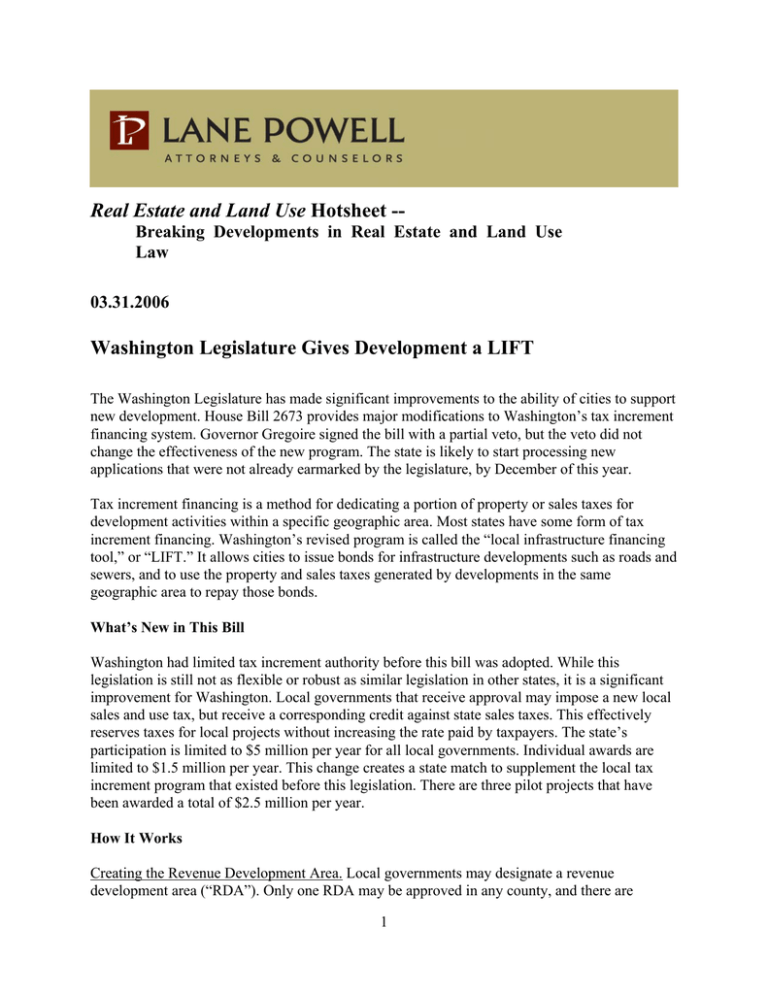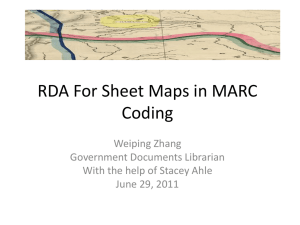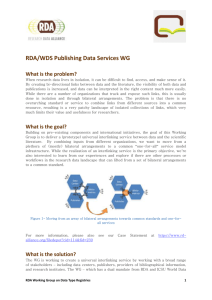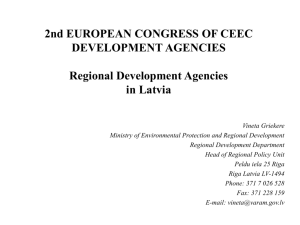Real Estate and Land Use Washington Legislature Gives Development a LIFT
advertisement

Real Estate and Land Use Hotsheet -Breaking Developments in Real Estate and Land Use Law 03.31.2006 Washington Legislature Gives Development a LIFT The Washington Legislature has made significant improvements to the ability of cities to support new development. House Bill 2673 provides major modifications to Washington’s tax increment financing system. Governor Gregoire signed the bill with a partial veto, but the veto did not change the effectiveness of the new program. The state is likely to start processing new applications that were not already earmarked by the legislature, by December of this year. Tax increment financing is a method for dedicating a portion of property or sales taxes for development activities within a specific geographic area. Most states have some form of tax increment financing. Washington’s revised program is called the “local infrastructure financing tool,” or “LIFT.” It allows cities to issue bonds for infrastructure developments such as roads and sewers, and to use the property and sales taxes generated by developments in the same geographic area to repay those bonds. What’s New in This Bill Washington had limited tax increment authority before this bill was adopted. While this legislation is still not as flexible or robust as similar legislation in other states, it is a significant improvement for Washington. Local governments that receive approval may impose a new local sales and use tax, but receive a corresponding credit against state sales taxes. This effectively reserves taxes for local projects without increasing the rate paid by taxpayers. The state’s participation is limited to $5 million per year for all local governments. Individual awards are limited to $1.5 million per year. This change creates a state match to supplement the local tax increment program that existed before this legislation. There are three pilot projects that have been awarded a total of $2.5 million per year. How It Works Creating the Revenue Development Area. Local governments may designate a revenue development area (“RDA”). Only one RDA may be approved in any county, and there are 1 several limitations related to assessed value. The sponsoring local government must enter into an agreement with a private developer regarding the developer's plans for projects within the RDA. The private development must be consistent with the county-wide planning policy and the local government's comprehensive plan. In creating the RDA, the government must make findings that the LIFT is not expected to be used for moving an existing Washington business from outside the RDA, into the RDA. The government must also find that the program will improve the viability of existing business entities within the RDA, and that the designated geographic area is in need of economic development or redevelopment. The local government must also find that the public improvements financed in whole or in part with the LIFT are reasonably likely to: 1. increase private investment within the RDA; 2. increase employment within the RDA; 3. generate, over a period of time that the local sales and use tax will impose, state and local property, sales and use tax revenues that are equal or greater than the respective state and local contributions made under this program; and 4. improve the viability of existing communities, and increase private residential and commercial investment within the RDA. The ordinance that establishes the RDA must include information about the public improvements to be constructed. It must also describe the boundaries of the RDA, estimate the cost of the public improvements and the portion of these costs to be financed by the LIFT, and estimate the time during which regular property taxes and excess excise taxes are to be used to finance the public improvement costs. The date when the apportionment of the taxes will begin must be identified. If the local government estimates that the RDA will have negative impacts on small businesses or low-income housing, it must develop a mitigation plan for those impacts. Other taxing entities that will be affected by the program must authorize use of their tax revenues. Tax Allocations Convert to Project Financing. Seventy-five percent of increases in property taxes generated by the sponsoring jurisdiction and those other jurisdictions that participate, from properties within the RDA, are allocated for indebtedness related to the program. In addition, the local government and participating overlapping jurisdictions may allocate excess excise taxes generated in the RDA for program indebtedness. The local government may impose a new sales and use tax, not to exceed 6.5 percent, less the aggregate rates of any other taxes imposed on the same event that are already credited against the state sales and use taxes. There are several limitations on the formula for establishing the amount of the tax, which must be approved by Community Economic Revitalization Board (“CERB”) in consultation with the Department of Revenue. Because the new sales and use tax is credited against the state sales and use tax, and paid over to the local government, it has the financial effect of capturing sales and use taxes from the RDA and making them available for this program, without increasing the tax rate from the taxpayer’s perspective. 2 The sponsoring jurisdiction may pledge the tax revenues to pay bonded indebtedness, and use the proceeds of the bonded indebtedness for eligible projects. This process is called tax increment financing. Eligible Projects and Costs. Within the RDA, LIFT money can be used to contribute to the cost of improvements including: street and road construction and maintenance; water and sewer system construction and improvements; sidewalks and streetlights; parking, terminal, and dock facilities; park and ride facilities of a transit authority; park facilities and recreational areas; and stormwater and drainage management systems. The funds may also be used for affordable housing. The infrastructure improvements must encourage private development, and the private development must be consistent with the local comprehensive plan. Eligible costs include: design; planning; acquisition; site preparation; construction; reconstruction; improvement and installation of public improvements; demolishing, relocating, maintaining and operating property pending construction of public improvements; financing costs; assessment incurred in revaluing real property and apportioning the taxes in the RDA; and reasonably related administrative and feasibility costs. The Application Process. Generally, the local government must apply to the CERB for an award. The Board must rule within 60 days of receiving an application. Applications may be filed anytime after August 1, 2006, but because the Department will have to hire staff and adopt rules governing the program, it is likely that the first application will actually be made after September 30th of this year. The last date for filing an application under this pilot program could be as early as September 30, 2009, but will likely be September 30, 2010. There are three demonstration projects that were authorized by the legislature and which must be approved before any competitive applications are approved. They are: The Bellingham redevelopment project ($1M per year), Spokane River district project ($1M per year) and Vancouver Riverwest project ($500K per year). The CERB will consider the following characteristics for the remainder of the applications: 1. the project's potential to enhance the sponsoring local government's regional and/or international competitiveness; 2. the project's ability to encourage mixed-use development and the redevelopment of a geographic area; 3. achieving an overall distribution of projects statewide that reflect geographic diversity; 4. the estimated wages and benefits for the project is greater than the average labor market area; 5. the estimated state and local net employment change over the life of the project; 6. the estimated state and local net property tax change over the life of the project; and 3 7. the estimated state and local sales and use tax increase over the life of the project. How To Use It Project sponsors who would like to use this tool should meet with community development officials to explore a local jurisdiction’s interest in using this program. This kind of infrastructure subsidy is best suited for large-scale projects, which may also be eligible for other types of subsidies. LIFT can be used most effectively if it is skillfully combined with other programs, such as New Markets Tax Credits, as part of a comprehensive financing program. New Markets Tax Credits is a federal subsidy source for commercial, retail and industrial projects. More information about that program and other forms of public-private partnerships is available on our website at www.lanepowell.com. For more information, please contact the Real Estate and Land Use Practice Group at Lane Powell: 206.223.7000 Seattle 503.778.2134 Portland realestate@lanepowell.com www.lanepowell.com We provide Real Estate and Land Use Hotsheet as a service to our clients, colleagues and friends. It is intended to be a source of general information, not an opinion or legal advice on any specific situation, and does not create an attorney-client relationship with our readers. If you would like more information regarding whether we may assist you in any particular matter, please contact one of our lawyers, using care not to provide us any confidential information until we have notified you in writing that there are no conflicts of interest and that we have agreed to represent you on the specific matter that is the subject of your inquiry. © 2006 Lane Powell PC Seattle - Portland - Anchorage - Olympia - London 4




